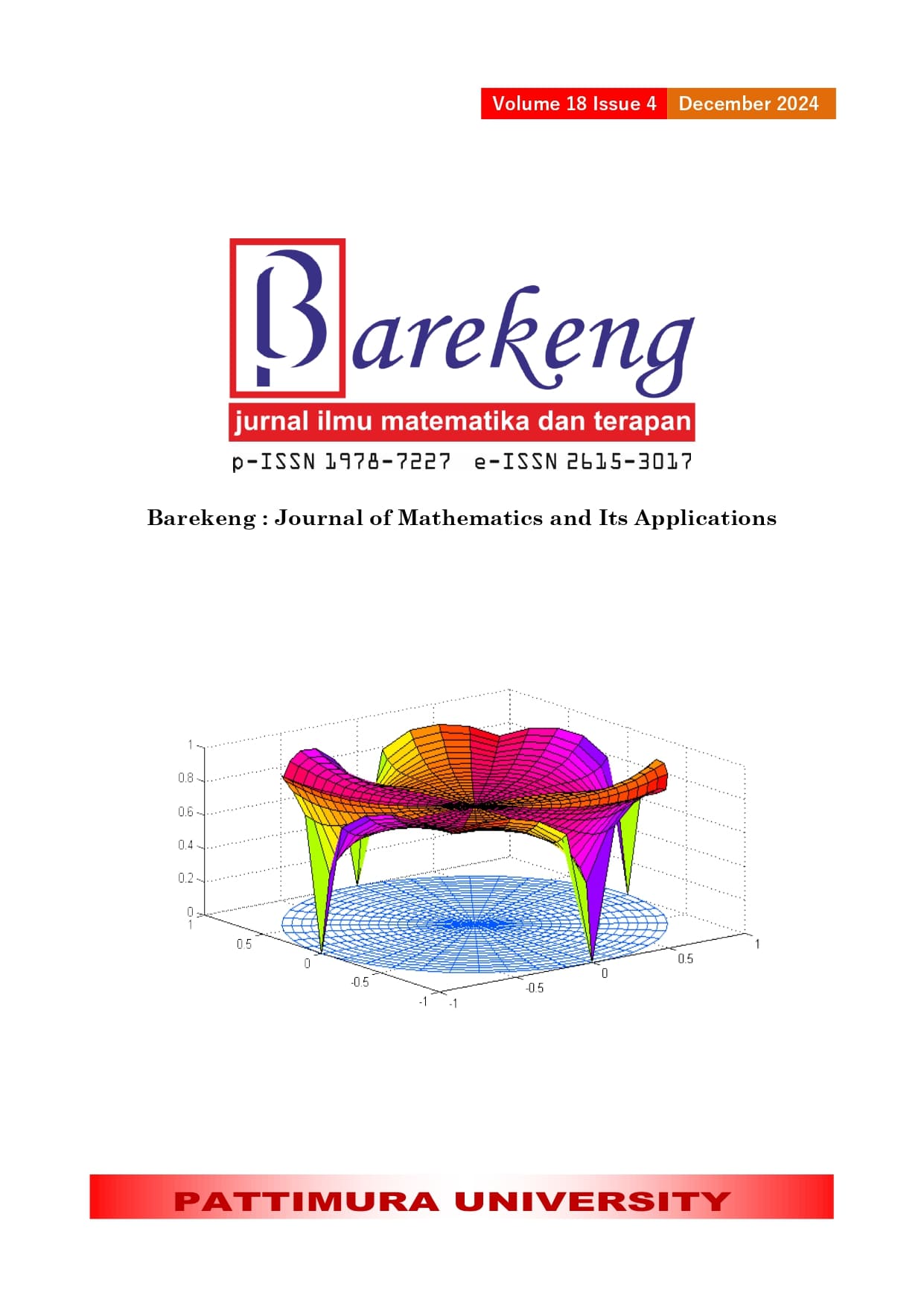ANALYSIS OF PORTFOLIO FORMATION ON THE LQ45 STOCKS INDEX, USING THE MARKOWITZ AND SINGLE INDEX MODELS
Abstract
In an investment, there will always be a return and risk, especially in the capital market in the form of stocks. The risk in an investment can be minimized by diversifying assets into several stocks to form a portfolio formation. Several models, such as the Single Index and Markowitz, can evaluate optimal portfolio formation. In this study we provide additional information and discourse on capital market studies and as the input for investors in making investment decisions in the form of stocks. The study shows that based on 25 companies, the Markowitz model gives 12 companies as the optimal portfolio with the largest proportion of funds owned by PT Bank Central Asia Tbk (BBCA), 82.22%. The portfolio of those 12 stocks can provide an expected return of 44.8% where its risk is about 13.77%. The Single Index model provides a formation based on 9 companies as the optimal portfolio with the largest proportion of funds owned by -again- PT Bank Central Asia Tbk (BBCA) which is 66.23%. The portfolio of these nine stocks can provide the expected return of 1.68% and its risk is 0.43%. The ratio of risk and return from each model justifies that the Single Index model gives better portfolio formation. This result should be further compared with other stock indexes, nationally and globally, and also needs to be compared with the period after the pandemic.
Downloads
References
E. Tandelilin, Analisis Investasi dan Manajemen Portofolio. Yogyakarta: BPFE, 2015.
E. Tandelilin, Pasar Modal Manajemen Portofolio & Investasi. Yogyakarta: PT. Kanisius, 2021.
M. Heykal, Tuntunan dan aplikasi investasi syariah. Jakarta: Elex Media Komputindo, 2012.
S. Husnan, Dasar-dasar Teori Portofolio dan Analisis Sekuritas, 4 ed. Yogyakarta: BPFE, 2005.
A. Gunawan, “BNI Sekuritas Galeri C Simanjuntak,” in Laporan Kerja Praktek, Jurusan Statistika UII, Yogyakarta, 2019.
D. Prastuti dan E. Septina, “The Analysis of Optimal Portfolio Using Single Index Model, The Case of Stocks Listed In Jakarta Islamic Index 2010-2013,” Indones. J. Business, Account. Manag., vol. 1, no. 01, hal. 67–73, 2018.
H. Jogiyanto, Teori Portofolio dan Analisis Investasi. Yogyakarta: BPFE, 2020.
J. Hartono, Teori portofolio dan analisis investasi: Pendekatan Modul, 2 ed. Yogyakarta: Penerbit Andi, 2022.
M. Arcos Mora, J. Benavides Franco, dan L. Berggrun Preciado, “Optimal portfolio allocation for Latin American stock indices,” Cuad. Adm., vol. 23, no. 40, hal. 191–214, 2010.
N. A. A. Santosa dan H. Sasongko, “Guarantee Product Portfolio: Performance and Optimal Portfolio Analysis,” JIMFE (Jurnal Ilm. Manaj. Fak. Ekon., vol. 6, no. 1, hal. 43–58, 2020.
A. Hanif, N. R. Hanun, dan R. E. Febriansah, “Optimization of stock portfolio using the markowitz model in the era of the COVID-19 pandemic,” Int. J. Appl. Bus., vol. 5, no. 1, hal. 37–50, 2021.
M. A. Muis dan S. Adhitama, “The Optimal Portofolio Creation Using Markowitz Model,” AFRE (Accounting Financ. Rev., vol. 4, no. 1, hal. 72–81, 2021.
A. Soraya, “Optimal Portfolio Formation with Combination of LQ45 Stocks and Corporate Bonds,” J. Keuang. dan Perbank., vol. 25, no. 4, hal. 970–983, 2021.
E. Susanti, N. Ervina, E. Grace, dan L. Siregar, “Comparison Analysis Of Optimal Portfolio Formation Results Using Single Index Model With Markowitz Model During The Covid 19 Pandemic In LQ 45 Index Company,” Int. J. Educ. Res. Soc. Sci., vol. 2, no. 5, hal. 1146–1156, 2021.
I. Mahmud, “Optimal portfolio construction: Application of Sharpe’s single-index model on Dhaka Stock Exchange,” JEMA J. Ilm. Bid. Akunt. dan Manaj., vol. 16, no. 1, hal. 60–92, 2019.
E. S. Nurhakim dan I. Yunita, “Construction Of Optimal Portfolio Using Single Index Model And Constant Correlation Model For Kompas 100 Index Over the Period 2014-2018,” eProceedings Manag., vol. 7, no. 2, hal. 3334–3340, 2020.
A. Gunawan, E. Pakki, dan F. R. Rahim, “Optimal Portfolio Analysis Using the Single Index Model,” Hasanuddin J. Bus. Strateg., vol. 3, no. 3, hal. 45–58, 2021.
E. M. Utami, L. Amaliawiati, S. Komariah, D. M. Puspitasari, dan O. Sinaga, “The Analysis of Optimal Portfolio Formation: The Evidence from LQ-45 during the Covid-19,” Rev. Int. Geogr. Educ. Online, vol. 11, no. 6, 2021.
Z. Maf’ula, S. R. Handayani, dan Z. A. Zahroh, “Portofolio Optimal dengan Penerapan Model Markowitz Sebagai Dasar Keputusan Investasi,” J. Adm. Bisnis (JAB)| Vol, vol. 63, no. 1, hal. 17–23, 2018.
R. Pal, T. D. Chaudhuri, dan S. Mukhopadhyay, “Portfolio formation and optimization with continuous realignment: a suggested method for choosing the best portfolio of stocks using variable length NSGA-II,” Expert Syst. Appl., vol. 186, hal. 115732, 2021.
F. S. Suqaier dan H. A. Al Ziyud, “The effect of diversification on achieving optimal portfolio,” Eur. J. Econ. Financ. Adm. Sci., vol. 32, hal. 55–63, 2011.
J. Hartono, Teori dan praktik portofolio dengan excel. Jakarta: Salemba Empat, 2024.
Copyright (c) 2024 Asmawi Gunawan, Rohmatul Fajriyah, M Albarra Bimakasa, Siti Nirmala Untari

This work is licensed under a Creative Commons Attribution-ShareAlike 4.0 International License.
Authors who publish with this Journal agree to the following terms:
- Author retain copyright and grant the journal right of first publication with the work simultaneously licensed under a creative commons attribution license that allow others to share the work within an acknowledgement of the work’s authorship and initial publication of this journal.
- Authors are able to enter into separate, additional contractual arrangement for the non-exclusive distribution of the journal’s published version of the work (e.g. acknowledgement of its initial publication in this journal).
- Authors are permitted and encouraged to post their work online (e.g. in institutional repositories or on their websites) prior to and during the submission process, as it can lead to productive exchanges, as well as earlier and greater citation of published works.






1.gif)



